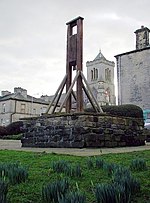Calderdale College
Buildings and structures in Halifax, West YorkshireEducation in CalderdaleFurther education colleges in West YorkshireUnited Kingdom university stubsUse British English from November 2021

Calderdale College is a further and higher education college based in Halifax, West Yorkshire, England. The college is the largest provider of further education (post-16) courses and work-based learning (apprenticeships) and—through University Centre Calderdale as part of a cooperation with Leeds Beckett University that began in 2006—the sole provider of higher education awards in the metropolitan borough of Calderdale.
Excerpt from the Wikipedia article Calderdale College (License: CC BY-SA 3.0, Authors, Images).Calderdale College
Francis Street, Calderdale Pellon
Geographical coordinates (GPS) Address Website External links Nearby Places Show on map
Geographical coordinates (GPS)
| Latitude | Longitude |
|---|---|
| N 53.72049 ° | E -1.87446 ° |
Address
Calderdale College
Francis Street
HX1 3UZ Calderdale, Pellon
England, United Kingdom
Open on Google Maps









